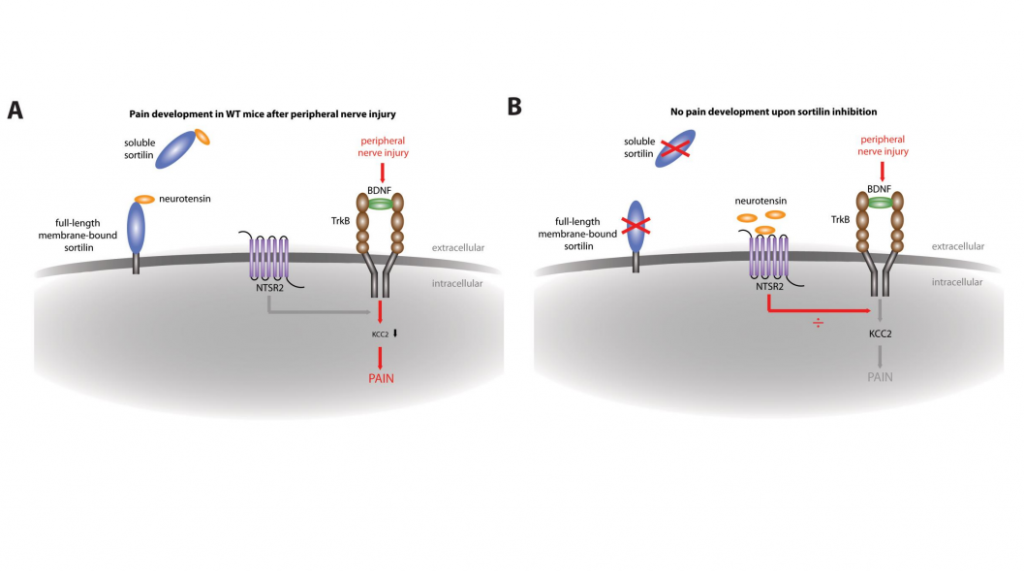Studies in laboratory mice awaken hope for efficient treatment of chronic pain
The protein sortilin plays an essential role in pain development in laboratory mice. This is shown in a new study that was recently published in the scientific journal Sciences Advances and includes researchers from the center of excellence PROMEMO. It is the researchers’ hope that the discovery can lead to the development of medicines for the benefit of patients with chronic pain.

Sortilin gates neurotensin and BDNF signalling to control peripheral neuropathic pain (Photo: AU)Sortilin is a protein expressed on the surface of neurons, and now a study shows that the protein plays an important role in pain development in laboratory mice – and likely in humans as well. This is the main conclusion of a study involving researchers from the DNRF’s Center for Proteins in Memory (PROMEMO) at Aarhus University (AU). In collaboration with colleagues from Canada, the Danish researchers have found that sortilin slows down the brake (the molecule neurotensin), which at the molecular level stops the body’s pain development.
“Chronic pain is triggered by overactive nerve cells, i.e., nerve cells where the regulation of their activity is not working properly. For this reason, it is necessary to gain knowledge of the changes happening at the molecular level to be able to ‘nudge things into place again.’ And it’s here, at the molecular level, that we’ve now added a crucial piece to a larger puzzle,” explained Assistant Professor Mette Richner, one of the main authors of the study. She added:
“Once nerve damage has occurred, and the nerve cells go into overdrive, molecules are released which start a domino effect that ultimately triggers pain. The domino effect can be inhibited by a particular molecule in the spinal cord called neurotensin, and our studies show that the neurotensin is ‘captured’ by sortilin, so that the brake is itself inhibited.”
A step closer to the relief of chronic pain
The new knowledge of the molecular processes is a big step for the researchers. They hope that the pharmaceutical industry will go further and investigate whether it is possible, for example, to block sortilin locally in the spinal cord, so that neurotensin can move freely to cause the brake to function and thus inhibit pain.
There is still a long way from experimenting with mice to a possible treatment for humans, but the result awakens a hope that effective drugs can be developed for patients suffering from chronic pain – a patient group that today does not have the prerequisites for effective medical treatment.
“Our research is carried out on mice, but as some of the fundamental mechanisms are quite similar in humans and mice, it still gives an indication of what is happening in people suffering from chronic pain,” said Professor Christian Vægter, who is the last author of the study.
Chronic pain can occur anywhere on the body and arise as a result of nerve damage. The cause may be anything from a bicycle crash to amputation, chemotherapy, or autoimmune and chronic diseases, such as diabetes. The pain occurs in the pain pathways and is typically characterized by different sensations, including burning, stinging, prickling, freezing, or stabbing in a chronic, disabling way.
About 8 percent of Denmark’s population suffers from chronic pain, and the number of patients is expected to increase in line with longer life expectancy and several lifestyle diseases.
The study is a result of 10 years of basic research and originally started as a Ph.D. project by Mette Richner, when she was a Ph.D. student in the Anders Nykjær’s research group. The DNRF has therefore supported the research, which has recently been published in the scientific journal Science Advances.
Find the scientific publication in Science Advances here
Read more about the study in a press release from PROMEMO here
